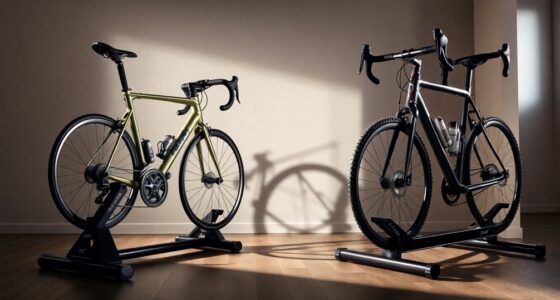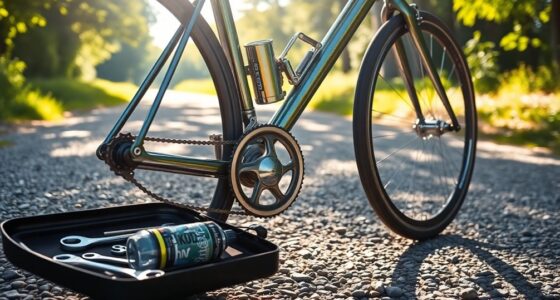Optimizing your bike's performance with regular tune-ups is essential for safety and longevity. Regular tune-ups help you catch minor issues before they turn into costly repairs. You'll enjoy smoother rides and efficient braking, enhancing your overall cycling experience. Check for signs like sluggish gear shifting or unusual noises. It's wise to balance professional services with some DIY maintenance. Keep following this guide to uncover more about the tune-up process and how to choose the right bike shop.
Key Takeaways
- Regular tune-ups enhance bike performance and ensure safety by addressing minor issues before they escalate into major problems.
- Frequent inspections improve shifting and braking efficiency, allowing for a smoother and more enjoyable ride.
- Professional tune-ups utilize advanced tools and expertise, ensuring all components are thoroughly checked and optimized.
- Maintaining proper tire pressure and wheel alignment through tune-ups boosts handling and stability during rides.
- Consistent maintenance extends the bike's lifespan, saving money on costly repairs and enhancing overall cycling enjoyment.
Importance of Regular Bike Tune-Ups
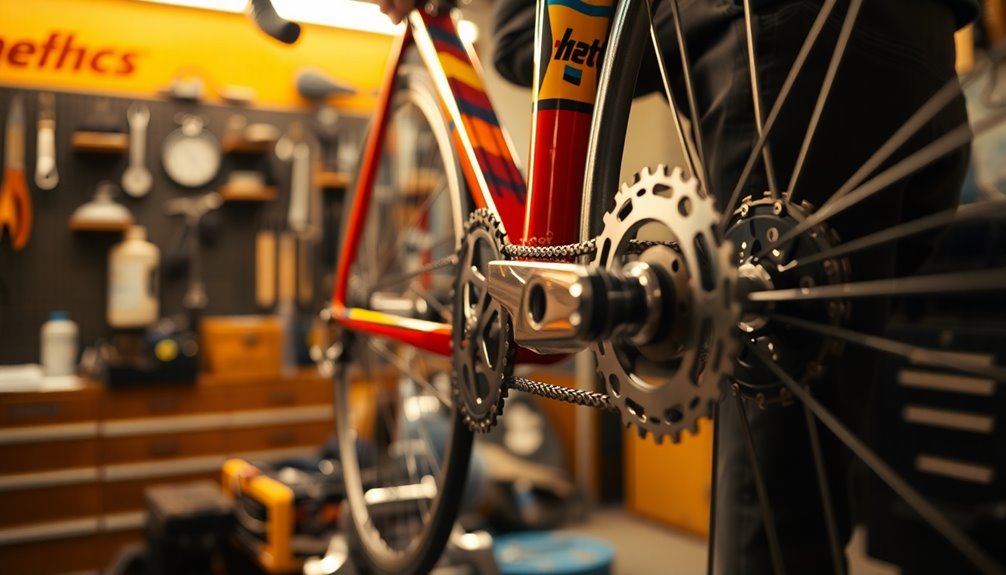
When you ride your bike regularly, you mightn't realize how essential it's to keep up with tune-ups.
Regular bike tune-ups play a vital role in maintaining your bike's performance and safety. They help you identify potential issues early, preventing costly repairs down the road. With professional tune-ups, you can address minor adjustments that combat wear and tear, ensuring your bike runs smoothly.
Frequent riders should aim for tune-ups every 2-3 months, while casual riders should consider annual check-ups. Neglecting maintenance can lead to significant breakdowns, making timely tune-ups a smart investment.
Benefits of Maintaining Your Bike
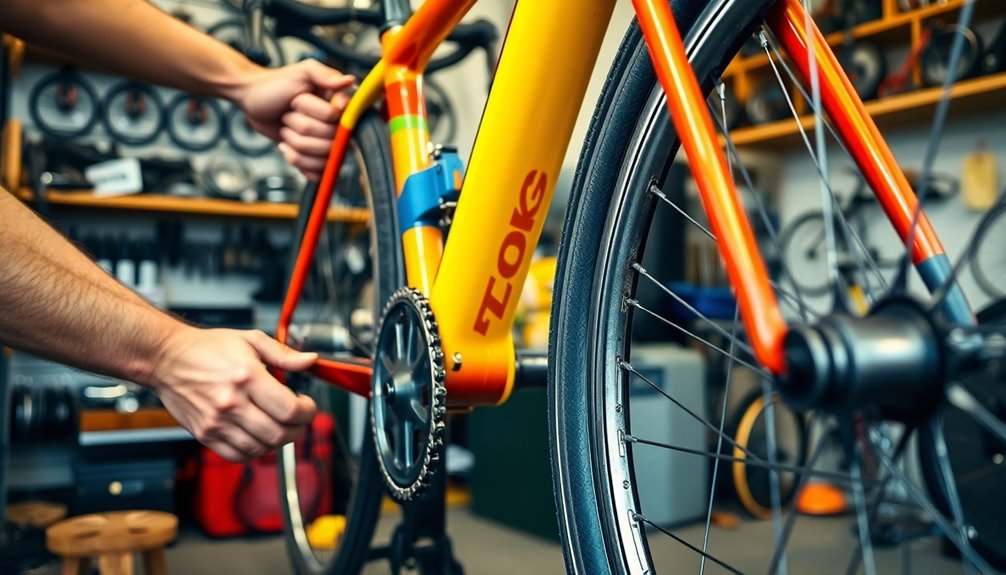
Maintaining your bike offers a range of benefits that go beyond just performance. Regular maintenance guarantees your bike stays in top condition, enhancing its efficiency and making your rides smoother and more enjoyable.
By addressing minor issues during tune-ups, you can prevent them from escalating into major problems that could lead to costly repairs. Tune-ups can prevent potential breakdowns and extend the lifespan of your bike, saving you money in the long run.
Additionally, a well-maintained bike enhances your safety, assuring that essential systems like brakes and gears function reliably. Regular tune-ups also help ensure that your bike's drivetrain components are in optimal condition, allowing for smooth shifting and improved ride quality. Ultimately, engaging in regular tune-ups allows you to focus on the joy of cycling, knowing your bike is ready for the road ahead.
Signs Your Bike Needs Attention
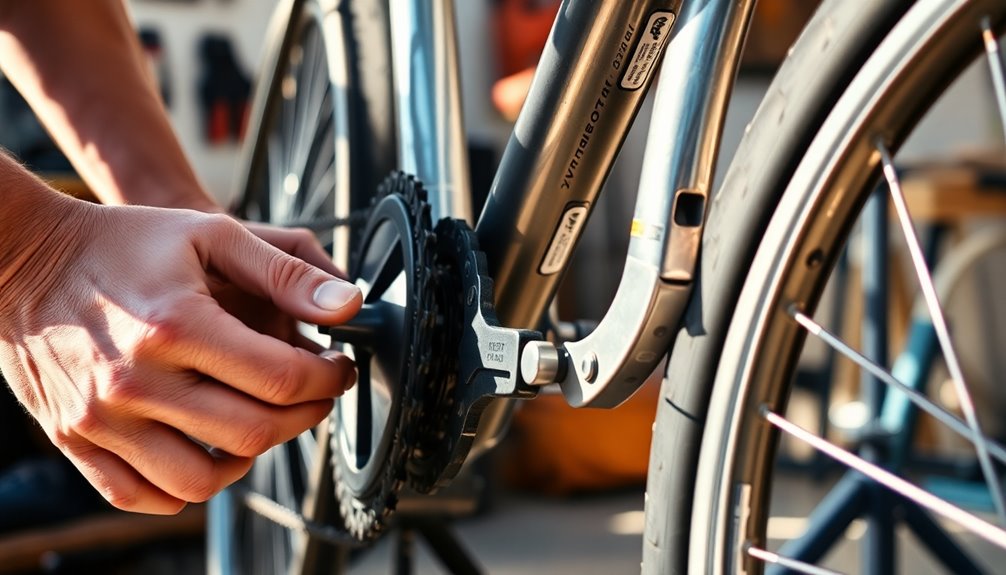
If you notice shifting issues or hear unusual noises while riding, it's time to pay attention to your bike.
Regular visual inspections can help catch problems early, ensuring a smoother and safer ride.
Keep an eye out for signs like decreased brake performance or sluggish efficiency, as these often indicate that your bike needs a tune-up.
Common Performance Indicators
Your bike's performance can reveal a lot about its condition, and recognizing common indicators of wear can save you from more serious issues down the road.
Here are some signs your bike needs a tune-up:
- Unresponsive or noisy brakes: Check your brake pads; they may need adjustment or replacement.
- Sluggish gear shifting: Worn cables or misaligned derailleurs could be affecting your ride, signaling a need for frequent tune-ups.
- Loose spokes or wobbly wheels: These issues can hurt stability and handling, necessitating a professional tune-up.
If you notice these signs of wear, don't hesitate.
Regular tune-ups can keep your bike in top shape and enhance your riding experience.
Unusual Noises and Issues
Noticing unusual noises while riding can be alarming and often points to underlying issues that need attention. Ignoring these signs can lead to major breakdowns, impacting your bike's performance. Regular maintenance is essential, and a tune-up includes checking components that might be causing these noises. Additionally, maintaining high vibrational energy during your rides can enhance your overall biking experience and performance.
| Unusual Noise | Possible Issue |
|---|---|
| Creaking or rattling | Loose or misaligned components |
| Skipping chain | Worn or damaged chain |
| Changes in steering | Loose headset or steering components |
| Worn tires | Tire wear or loose spokes |
| Strange sounds | Need for overall maintenance |
Addressing these unusual noises promptly guarantees your bike remains safe and performs at its best. Don't overlook the signs—stay proactive with tune-ups!
Visual Inspection Checklist
A thorough visual inspection is essential for maintaining your bike's performance and safety.
Regular inspections help you catch issues before they become serious. Here's a quick checklist to guide you:
- Brakes: Inspect brake pads for wear; replace them if metal is showing to guarantee effective braking performance.
- Tires: Check for cuts, wear, or debris and maintain proper inflation to prevent flats.
- Components: Examine the headset and all parts for looseness, as this can affect steering stability.
Don't forget to listen for unusual noises like creaking or rattling, which may indicate misaligned parts.
Regular cleaning and maintenance will keep your bike in top shape, guaranteeing a safe and enjoyable ride every time.
Recommended Tune-Up Frequency
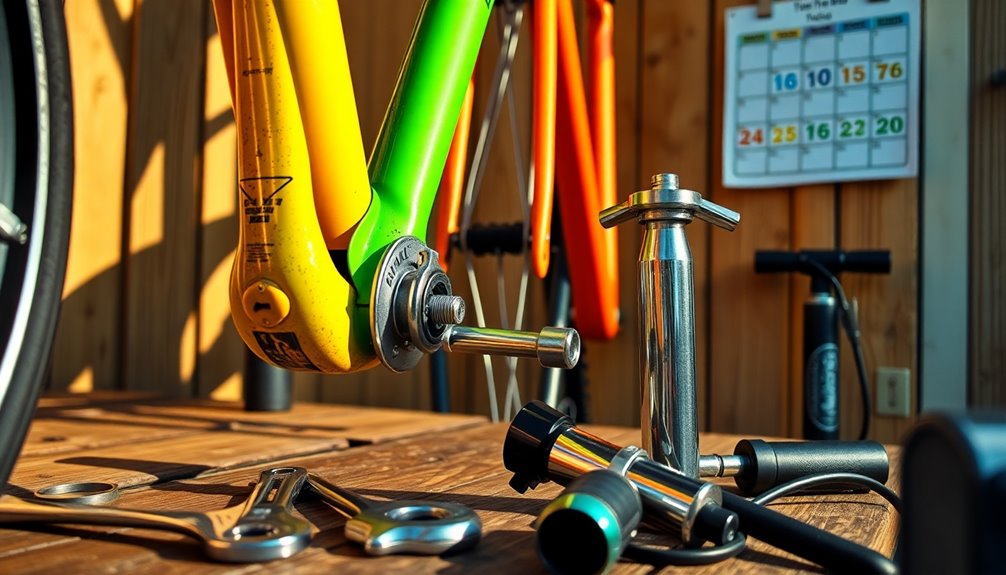
Maintaining your bike's performance is vital, and the recommended tune-up frequency varies based on your riding habits.
If you're an avid cyclist, aim for a tune-up every 2-3 months to guarantee peak performance and safety. Casual riders typically benefit from an annual tune-up to effectively address wear and tear.
Seasonal riders should schedule at least one tune-up per season, preparing their bikes for the diverse weather conditions and terrain they'll encounter.
If you often ride in extreme conditions like off-road trails or heavy rain, more frequent tune-ups are important to prevent damage and maintain reliability.
Regular maintenance tailored to your riding style can greatly extend your bike's lifespan and prevent costly repairs down the line.
Professional Tune-Ups vs. DIY Maintenance
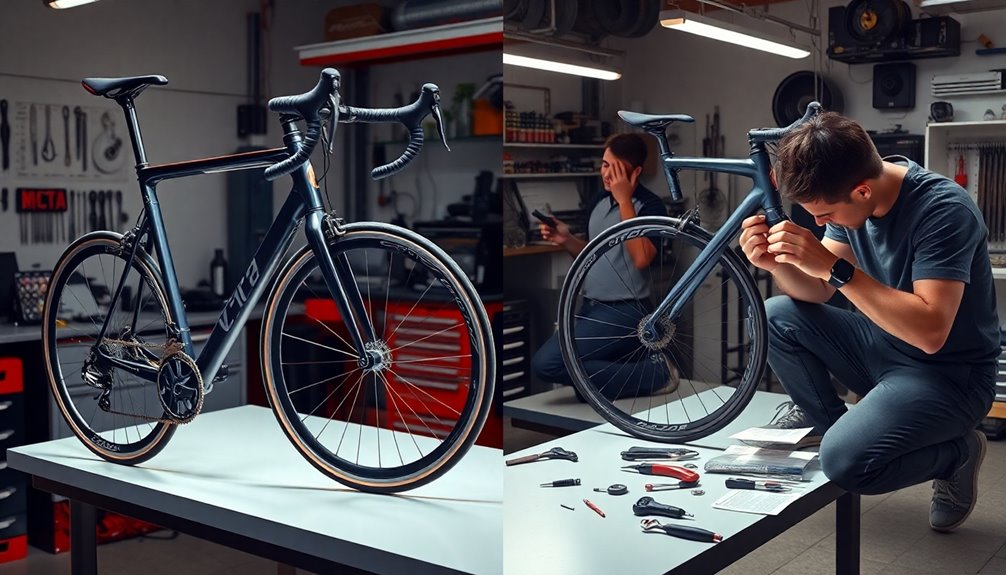
Regular tune-ups are just one part of keeping your bike in top shape.
Regular tune-ups play a crucial role in ensuring your bike remains in optimal condition.
When deciding between professional tune-ups and DIY maintenance, consider the benefits each offers. Professional services provide a thorough inspection by trained mechanics who can spot complex issues a casual rider might miss.
Meanwhile, DIY maintenance can save you money but might lack the precision of a professional tune-up.
Here's a quick comparison:
- Expertise: Professionals use advanced tools for better accuracy.
- Thoroughness: A professional tune-up guarantees all components are in good working order.
- Cost-effective: DIY is great for basic tasks but may overlook significant problems.
Additionally, engaging in regular maintenance can greatly enhance color accuracy which is crucial for a smooth and enjoyable ride.
For peak bike ownership, balance DIY maintenance with professional tune-ups for lasting performance.
Essential Components of a Bike Tune-Up

While you might think of tune-ups as just a formality, they actually play an essential role in keeping your bike safe and performing at its best.
A thorough bike tune-up includes important brake adjustments to guarantee you can stop quickly and safely. Gear adjustments help align the derailleur, allowing for smooth and quiet shifting during your rides.
Tire inspection is critical, as it prevents flats and enhances comfort by checking inflation levels. Additionally, lubrication of the chain and moving parts reduces friction and prevents rust, boosting your bike's efficiency.
Don't forget about wheel truing, which corrects any wobbles for improved stability. Regularly attending to these components guarantees an enjoyable and safe biking experience.
Cost Range for Bike Tune-Ups
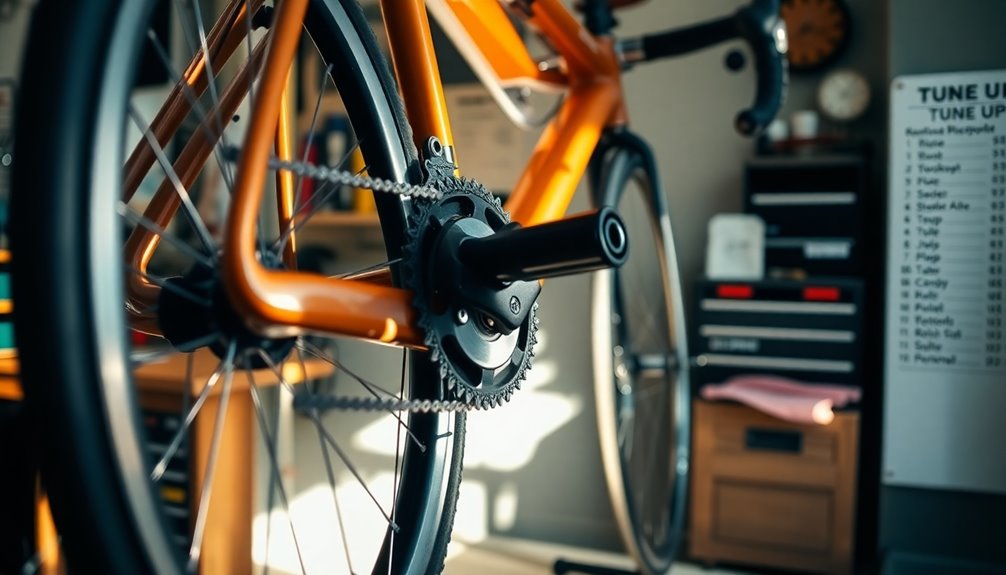
Understanding the cost range for bike tune-ups is essential if you want to keep your ride in top shape without breaking the bank.
Regular tune-ups typically cost between $50 and $100, covering basic adjustments and inspections. If your bike's heavily used, extensive tune-ups can range from $150 to $200, addressing cleaning and potential part replacements.
Consider these factors when budgeting:
- The bike's condition and needed repairs
- The expertise of the service provider
- Potential package deals for multiple tune-ups
Investing in regular tune-ups not only enhances performance but also helps in preventing more significant repair issues down the line.
Choosing the Right Bike Shop for Tune-Ups

Finding the right bike shop for tune-ups can make a significant difference in your cycling experience.
Start by looking for shops with skilled mechanics who understand various bike types and can tailor their services to your riding style. It's crucial to choose a shop that offers an extensive range of tune-up services, from basic adjustments to thorough overhauls, ensuring your bike gets the upkeep it needs.
Don't forget to check customer reviews to assess the shop's reputation for quality service and satisfaction. A shop that emphasizes preventative maintenance can help catch potential issues early, saving you money in the long run.
With these factors in mind, you'll find a reliable bike shop that keeps your ride in top shape.
Frequently Asked Questions
What Does a Full Bike Tune up Include?
A full bike tune-up includes several essential tasks.
You'll get brake adjustments for responsive stopping power and gear adjustments for smooth shifting.
The technician will inspect and inflate your tires to prevent flats and enhance comfort.
They'll also lubricate the chain and moving parts to reduce friction and prevent rust.
Finally, wheel truing guarantees proper alignment and stability, making your ride safer and more efficient.
Regular tune-ups keep your bike in top shape!
How Often Do Bikes Need Tune Ups?
How often your bike needs tune-ups depends on how you ride it.
If you're an avid cyclist, aim for every 2-3 months. Casual riders should get one at least once a year, while seasonal riders might want to schedule a tune-up each season.
If you ride in extreme weather or on rugged terrain, more frequent checks are essential. Regular maintenance helps catch minor issues before they turn into major problems.
Is It Worth Tuning up an Old Bike?
Is it worth tuning up an old bike? Absolutely!
Think of your bike as a trusty steed, and a tune-up is like a spa day—refreshing it for more epic adventures!
You'll notice smoother rides, better brakes, and a gear system that shifts like butter.
Plus, for just a fraction of the cost of major repairs, you're extending its life.
How Can I Improve My Bike Tuning?
To improve your bike tuning, start by regularly inspecting your brakes and adjusting them for better responsiveness.
Confirm your gears are aligned for smooth shifting and quiet operation.
Clean your bike often and lubricate the chain to reduce friction.
Check your wheels for trueness and maintain proper tire inflation for a smoother ride.
Finally, schedule tune-ups based on how often you ride—more frequently for avid cyclists, less for casual ones.
Conclusion
In the grand journey of cycling, think of regular tune-ups as the gentle hands of a skilled mechanic, fine-tuning your bike's heart. With each adjustment, your ride transforms, gliding smoothly like a whisper on a breeze. By nurturing your bike, you're not just preserving its performance; you're crafting unforgettable adventures. So, embrace those routine check-ups, and watch as your bike flourishes, ready to conquer new paths and embrace the open road with you.


